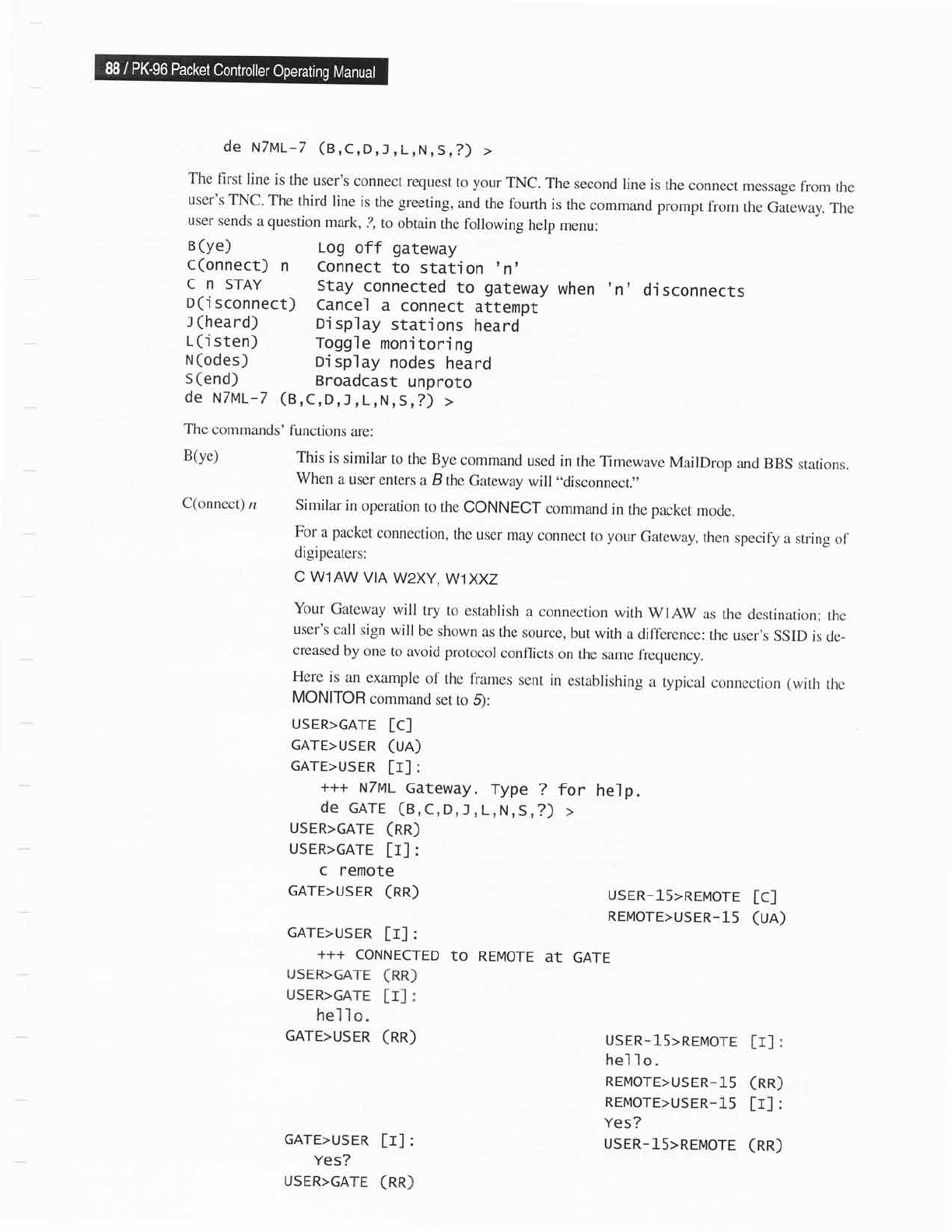Specifications
Table Of Contents

de ru7ul-7
(B,c,D,J,L,N,s,?)
>
The
first
line
is
the user's
connect
request
to
your
TNC.
The
second
line
is
the
connect
message
from
the
user's
TNC.
The
third
line
is
the
greeting,
and
the fourth
is the
command
prompt
from
the
Gareway.
The
user
sends
a
question
mark,
?,
to obtain
the following
help
menu:
e
(ye)
log
off
gateway
C(onnect)
n
Connect
to station
'n'
C n
STAY
Stay
connected
to
gateway
when
,
n,
d.i sconnects
o(isconnect)
cancel
a
connect
attempt
:(heard)
oisplay
stations
heard
t-
(i
sten)
Toggl
e moni
tor.i
ng
tl
(odes)
s
(end)
oisplay
nodes
heard
Broadcast
unproto
de
NTML-7
(B,c,D,J,
L,N,S,?)
>
The
commands'
functions
are:
B(ye)
This
is
similar
to the
Bye
command
used
in
the
Timewave
MailDrop
and BBS
stations.
When
a user
enters
a
I the
Gateway
will
,,disconnect."
c(onnect)
n
similar
in
operation
to
the coNNEcr
command
in
the
packet
mode.
For a packet
connection,
the
user
may
connect
to
your
Gateway,
then
specify
a string
of
digipeaters:
C WlAW
VIA
W2XY.
WlXXZ
Your
Gateway
will
try
to
establish
a
connection
with
WIAW
as
the
destination;
the
user's
call
sign will
be shown
as
the
source,
but with
a difference:
the user's
SSID
is
de-
creased
by
one
to avoid protocol
conflicts
on
the
same
frequency.
Here
is
an
example
of the
fiames
sent
in
establishing
a typical
connection (wit.h
the
MONITOR
command
ser
ro
O:
USER>GATE
TC]
GATE>USER
(UA)
GATE>USER
[I]:
+++
NTML
Gateway.
Type
?
for
he1p.
dC
GATE
(B,C,D,J,L,N,S,?)
>
USER>GATE
(NN;
USEbGATE
[r]
:
c remote
GATE>USER
(RR)
GATE>USER
[r]:
+++
CONNECTED
USEbGATE
(RR)
USER>GATE
[T]:
hel
I
o.
GATE>USER.
(RR)
GATE>USER
[r]:
yes?
t,sER>GATE
(nn)
usER-15>REMOTE
Ir]:
hel
I
o.
REMOTE>USER-1s
(nn)
REMOTE>USER-15
[r]:
yes?
usER-]_5>REMOTE (nn)
usER-15>REMOTE
tCl
REMOTE>USER-1s (Un)
tO REMOTE
At
GATE










